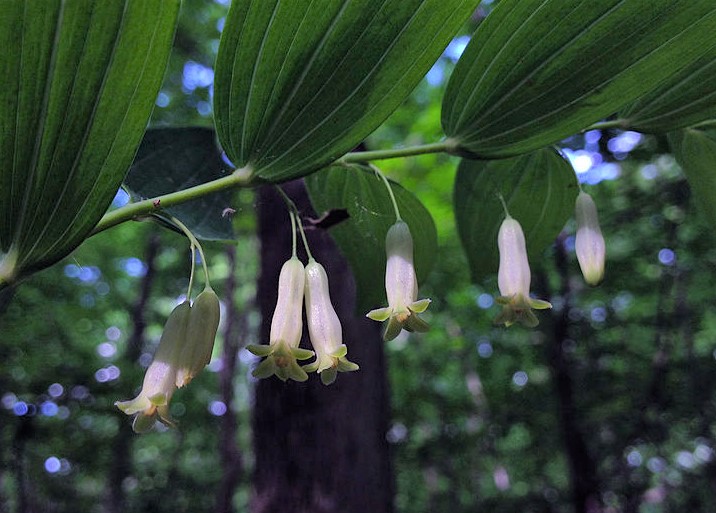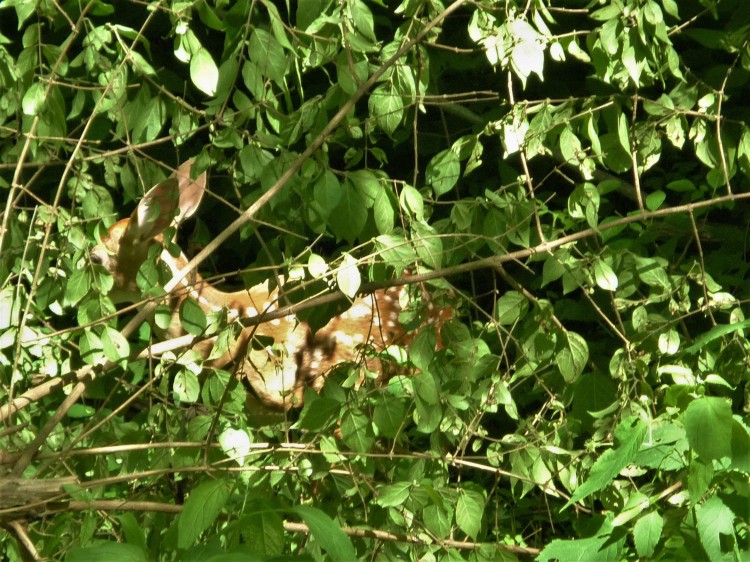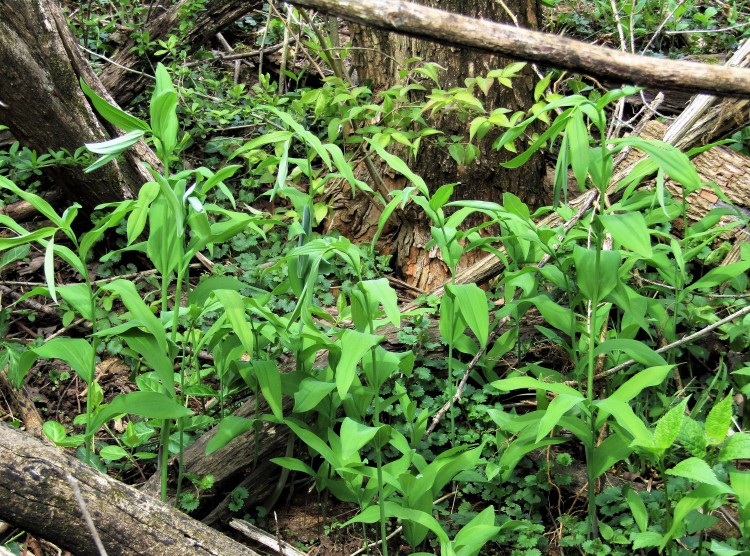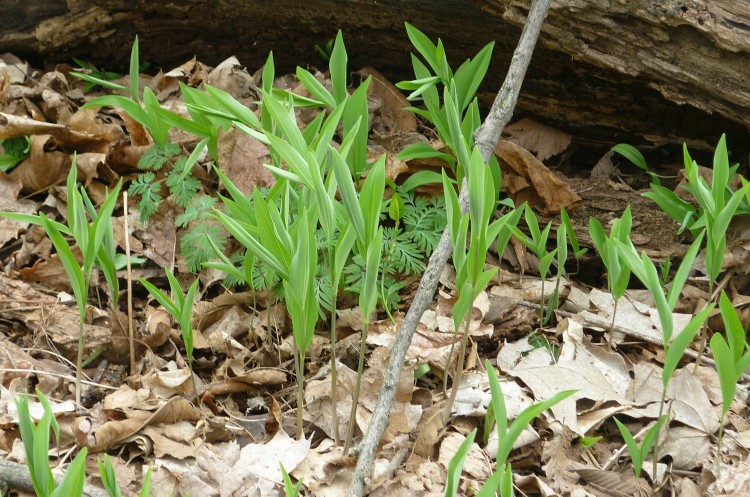
Once upon a time, Solomon’s Seal Polygonatum biflorum, dangled its creamy bell-like blooms all over this forest. Then came Bush Honeysuckle and deep shade. Even then Solomon’s Seal bloomed along the trail where light could reach it. Then came deer and no more flowers. Like discerning foodies seeking the perfect meal, whitetails parse the forest floor and they don’t miss much. A better common name for Solomon’s Seal would be “Deer Asparagus” (it’s closely related).

If you’re a plant in the top 10 on the deer “preferred” list, things are not going well for you. But I want to see Solomon’s Seal bloom in this forest. The battle of wits between human and herbivore begins again, and my deer exclusion architecture must go to a new level. No more little piles of sticks; something more structural is needed. On the hillside in the pic above I found a lot of sturdy, decay resistant Black locust limbs. They interlocked nicely, forming a solidly balanced structure that doesn’t look out of place. This one is rather minimal and would need more work to really protect a Solomon’s Seal patch.

Observing how deer behave as they move through the forest is helpful – when I see them standing in the middle of a seemingly impervious brush pile it’s time to get more creative! Thinking like a deer is key; would I jump into the midst of these tangled branches and risk breaking a leg for the sake of a few tasty plants? The structure below works so well because it’s anchored around a tree and large fallen limbs that were already in place.

This sturdy shelter contains a nice little patch of plants with two years of no bite-offs. Many of the plants have now stored enough energy to produce flowers, and I hope to share them in a future post. Healthy patches expand, so the shelter will need to as well. The idea of protecting plants that are already growing here came to me when I saw some young Sassafras trees thriving inside a thorny Multiflora Rose thicket. The little trees around it that were easy to get to all had their heads bit off.

If you walk through this forest you’ll see many brush structures, so a question I get asked a lot is: what are all those stick piles for? I love to explain, since people don’t always realize the impact whitetails have on forests. The population density here is high and growing, (two more fawns per doe every spring) and deer “management” in our metro area is unlikely. If whitetails continue to eat all the desirables, the flora of this forest will become more and more depauperate, and plants like poisonous White Snakeroot will cover most of the forest floor.

Is it obsessive to build these things all over the place? Maybe – but as it turns out, brush structures are also great habitat and beloved by birds, small mammals, snakes and Box turtles. They help substitute for the shrubby native understory that will take some years to recover after Bush honeysuckle removal. And of course I can’t fence in every patch of tasty wildflowers – I can only hope to create some “islands of diversity” in between the deer trails!

Owen Hardy
Great post. So glad I found your blog!
LikeLiked by 1 person
tonytomeo
I was just telling someone else that when we were in school, the flower stalks of the native yuccas were like asparagus to us. We had to get them when they were about a foot tall, and peel the tough outer part off, but they tasted just like asparagus. They were so fat, that we needed only one at a time. The only sad part of this is that it deprived the yucca of its spectacularly tall blooms!
LikeLiked by 1 person
oneforestfragment
Great story! Yuccas were commonly planted here years ago and I remember the amazing flowers. In our area they seem to have fallen out of favor as a garden planting.
LikeLiked by 1 person
tonytomeo
Although some are just plain weedy, and some have nasty spines that are not very friendly up close, many yuccas really should be used in arid climates more than they are. I noticed many in New Mexico and Arizona. However, we do not like them so much in California. The common giant yucca is rather cliche. There are so many others that I would prefer to see (although I like the giant yucca too).
LikeLiked by 1 person
oneforestfragment
yes, cliche is the word, though I like them. They seem to be going the way of the privet hedge, the peonies, the concrete dog and the shrine to virgin Mary – all of which were common in front yards when I was a child! When my kids were young we read a book about Native American plant uses, and learned the yucca root could be used as soap. Soon after we found a big one that had been ripped up from a yard, and got to try it out.
LikeLiked by 1 person
tonytomeo
It does not go very far as soap. I certainly would not want to pull up a yucca just to wash with it.
LikeLiked by 1 person
oneforestfragment
Nor would I, but this one had been discarded because it was cliche!
LikeLiked by 1 person
tonytomeo
Well, soap is probably a better use that what I do with them. When I find them in a recycle pile, I take them home and grow them until I can find a home for them!
LikeLiked by 1 person
oneforestfragment
That’s a great idea; wish I had done that and we’d have the only yucca for miles around. Does the Yucca moth occur in your area?
LikeLiked by 1 person
tonytomeo
I have never seen a yucca moth, and have never seen a yucca making seed outside of the respective native range. The (Hespero)Yucca whipplei south of here make quite a few fruits, so must be getting pollinated by their yucca moth. I do not know if they get pollinated by anything else. Nor do I know if their yucca moth will also pollinate other specie of yucca. The common giant yucca from Central America never fruits here.
LikeLiked by 1 person
tonytomeo
Yucca actually has a few uses.
LikeLike
sweetgumandpines
I really like your idea of using brush piles to protect wildflowers. Since putting up a deer fence around our garden, I have noticed Polygonatum biflorum appearing here and there. This year, there seems to be lots of seedlings, which pleases me.
LikeLiked by 1 person
oneforestfragment
Thanks! Necessity is the mother of…. and brush structures can look artistic. Trampling alone is enough to do damage when a herd hangs out in one area. Spring ephemerals in deer infested forests are often smaller, according to some research I read.
LikeLiked by 1 person